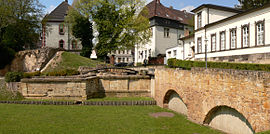Office Peine
|
Hildesheim Monastery ; Kingdom of Hanover ; Prussian Province of Hanover |
|
|---|---|
| Office Peine | |
|
The Schlossberg in Peine, today the seat of the Peine District Court |
|
| main place | Torment |
| Incorporated into | District of Peine |
| surface | 4,094 Hanover square miles (approx. 225 km²) |
| Residents | approx. 9300 (office and city of Peine around 1855) |
| Villages and hamlets | 39 (around 1885) |
| Cities | 1 |
Position of the main town on a map of today's Lower Saxony
|
The office of Peine in today's Lower Saxony was a historical administrative area of the Prince Diocese of Hildesheim , later the Kingdom of Hanover and the Prussian Province of Hanover . The Landdrostei Hildesheim has been the higher administrative level since 1823 .
history
The castle Peine was since 1260 owned by the Bishopric of Hildesheim and soon became the center of a prince-bishop's office , whose office Sprengel until the 18th century has remained largely unchanged. The administration was divided into four bailiffs. The administrative seat was on the Schlossberg in Peine , today's district town of the Peine district .
In 1802 the office came to Prussia with the bishopric , then to the Kingdom of Westphalia . After the end of the Franco-Westphalian rule, it was restored in the Kingdom of Hanover in 1815, but in 1852 it was divided into the Office Peine and the Office Hohenhameln zu Peine. Large and small Lafferde and Lengede came to the Steinbrück office . In 1859 the reform was revised, the two offices were reunited and the three offices that had been handed over to Steinbrück were returned. In addition, the municipality of Eixe came to Peine from the Meinersen office .
In 1885 the Peine office was abolished and incorporated into the district constitution.
Communities
![]() Map with all linked sites of the Peine Office: OSM | WikiMap
Map with all linked sites of the Peine Office: OSM | WikiMap
When it was abolished in 1885, the office comprised the following municipalities:
- Adenstedt
- Adolphshof / Hämelerwald
- Bekum
- Berkum
- Mountains of beer
- Curl
- Claws
- Dungelbeck
- Eixe
- Equord
- Gadenstedt
- Groß Bülten
- Great Ilsede
- Large loaf soil
- Groß Solschen
- Handorf
- Hofschwicheldt
- Hohenhameln
- Klein Bülten
- Klein Ilsede
- Small loaf soil
- Klein Solschen
- Lengede
- Mehrum
- Münstedt
- Oberg
- Ohlum
- Reddish
- Rosenthal
- Rüper
- Schmedenstedt
- Schierke
- Schwicheldt
- Saußmar
- Stedum
- Telgte
- Vöhrum
- Wense
- Woltorf
Drosten and bailiffs
Drosten
- 1605–1619: Hermann von Kettler
- 1621–1628: Christoph Dietrich von Bock
- 1628–1637: Jobst Adrian von Wendt
- 1637–1643: Rötger (?) Von Kettler
- 1643–1651: Johann von Neuhof
- 1651–1664: Kaspar Andreas von Voss
- 1665–1669: Friedrich von OIeynhausen
- 1670–1685: Franz von Frentz
- 1685–1702: Hermann Stephan von Bockenförde
- 1702–1703: Ernst Leopold von Bockenförde
- 1707–1727: Kaspar Friedrich von Hoheneck
- 1728–1753: Gottfried Conrad Gaudenz von Bocholtz
- 1753–1757: Johann Wilhelm Franz Graf von Nesselrode
- 1757–1784: Ferdinand Wilhelm von Bochholtz
- 1784–1792: Alexander Hermann von Merode-Houffalize
- 1792–1802: Wilhelm Arnold von Kettler
Bailiffs
- –1608: Albrecht von Hoya
- 1608–1618: Wilbrand von Schoten
- 1618–1637: Werner von Rittersbach
- 1637–1649: Johann Hochrath
- 1649-1668: Michael Call
- 1668–1685: Martin Solemacher
- 1685-1712: Melchior Kempis
- 1712–1745: Anton Rudolf Gronefeld
- 1745–1762: Otto Gerhard Heinrich Gronefeld
- 1762–1766: Franz Heinrich Ludwig von Walbeck
- 1766–1815: Damian Josef von Lochausen
- 1818–1824: Albrecht Georg Friedrich Baring, State Economics Council
- 1824–1826: Johannes Friedrich Ziegler, bailiff (by order)
- 1826–1832: Friedrich Wilhelm Christian Westfeld, bailiff
- 1832–1834: Meyer, Amtmann
- 1835–1864: Ernst Christian Friedrich von der Wense , Drost
- 1870–1873: August Hoppenstedt , councilor, from 1868 bailiff
- 1870–1877: Julius Karl Freiherr von Dörnberg, bailiff
- 1877–1880: Luis Freiherr von Grote, bailiff
- 1881–1882: Berthold Theodor Thon, bailiff
- 1883–1885: Bernhard Baurschmidt , bailiff, 1885–1888 District Administrator of the newly founded district of Peine
literature
- Iselin Gundermann , Walther Hubatsch : Outline of the German administrative history 1815-1945 . Row A: Prussia, Volume 10: Hanover. Marburg (Lahn) 1981
- Manfred Hamann : Overview of the holdings of the Lower Saxony Main State Archives in Hanover. Third volume: Central and subordinate authorities in the Landdrostei and administrative districts of Hanover, Hildesheim and Lüneburg until 1945. Göttingen 1983, pp. 378–380.
- Thomas Klingbiel: A stand of its own? Local officials in the early modern period: Studies on state formation and social development in the Hildesheim Monastery and in the older Principality of Wolfenbüttel . Hannover 2002, pp. 670-683
- EFJ Koch: History of the dynasty, the office, the city, castle and fortress Peina in Lower Saxony . Peine 1850
Individual evidence
- ↑ Friedrich W. Harseim, C. Schluter (ed.): Statistical Manual for the Kingdom of Hanover . Schlueter, 1848, p. 71.
- ^ Georg von Viebahn : Statistics of the customs united and northern Germany . Reimer, Berlin 1858, p. 393

